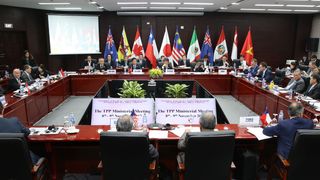The Comprehensive and Progressive Agreement for Trans-Pacific Partnership (CPTPP) to be signed in Chile on 8 March is a welcome step to freer trade in the Pacific region. Yet the absence of the United States from the agreement also highlights how much has changed since the United States signed the previous Trans-Pacific Partnership Agreement in February 2016, before “permanently” withdrawing in January 2017 following the election of President Trump.
The Trump administration has presided over a radical change in US trade and foreign policy that makes the long-standing aspiration to build a comprehensive free trade area in the Pacific look increasingly remote. It calls into question the support the United States has historically provided to the global liberal trading system and its role in underpinning international security.
While President Trump has indicated an in-principle willingness to re-enter the agreement based on “a substantially better deal”, the CPTPP already looks very much like an agreement the United States would have signed prior to his election. It includes 22 suspended provisions on which the United States previously insisted that can be reactivated to facilitate US admission.
But the Trump administration’s mercantilist fixation on economically irrelevant trade balances, rather than maximising the total volume of two-way trade, makes future agreements on the scale on CPTPP unlikely. The United States might still walk away from the very successful North American Free Trade Agreement (NAFTA) with Canada and Mexico, damaging its own and neighbouring economies.
Even bilateral agreements, which the Trump administration claims to favour, will be hard for the United States to negotiate. The attempt to renegotiate the Korea-US (KORUS) agreement already has the United States making impossible demands, such as “balanced” trade in the automotive sector. Given the relative size of the Korean and US car markets, balanced trade in this sector is simply not feasible, much less desirable.
The United States might still walk away from the very successful North American Free Trade Agreement with Canada and Mexico, damaging its own and neighbouring economies.
Recent US “safeguard” duties on solar panels and washing machines, as recommended by the independent International Trade Commission, are not unprecedented. Previous US administrations have used them. However, the current administration is less likely to view such measures as exceptional, but as part of a systematic approach to “rebalancing” trade that will increasingly harm the United States and world economy.
Since the end of the Second World War, free trade and a liberal international trading system have been a foundation of US prosperity, but also a very effective arm of its foreign policy. Free trade reinforced the economic strength of key allies and fostered economic development in countries that might otherwise have been more vulnerable to anti-Western ideologies. The post-war rise of East Asia was largely built on trade, giving rise to growing middle classes and democratic reforms, while reinforcing the network of security alliances with the United States.
This framework was extended to accommodate China’s rise after its economic reforms beginning in the late 1970s. US support for China’s accession to the World Trade Organization (WTO) in 2001 was seen as supporting the convergence of its economy with the liberal international order while assisting China in progressing its domestic economic reforms.
Nowhere is the change in US policy more evident than its approach to China. The United States now claims that it was a mistake to bring China into the WTO. The new National Security Strategy released late last year defines China as a “strategic competitor” and this strategic logic is being extended from the security to the economic realm.
The Trump administration argues that the WTO was never equipped to handle a mercantilist regime such as China. Yet the administration’s response to China’s mercantilism has been to adopt a similarly mercantilist approach that puts trade balances at the centre of US trade and foreign policy.
In moving from engagement to confrontation in the economic realm, the United States risks becoming that which it claims to oppose. To the extent that China maintains mercantilist policies, these are a drag on its own as much as other economies. The best way to defeat mercantilism is to lead by example and show the world how free trade promotes prosperity.
China will see US actions as legitimating its own mercantilist instincts and policies, reinforcing its belief in its own economic model as distinct from the previously US-dominated international liberal order. Free trade will lack a global champion and it will be left to middle powers and traditional US allies like Australia to carry the baton for free trade.
Rather than setting the stage for a new era of free trade in the Pacific, CPTPP may end up as an obituary for the liberal international trading system formerly led by the United States.






